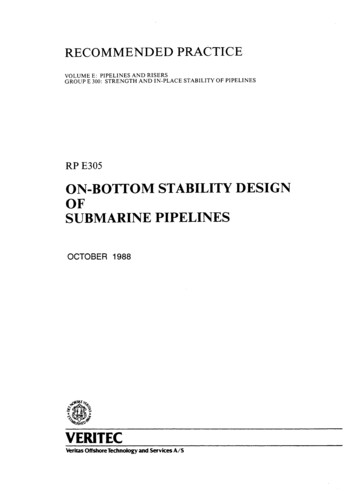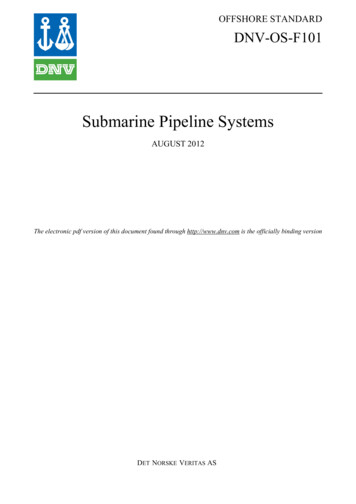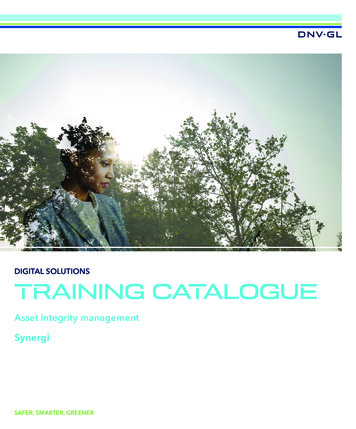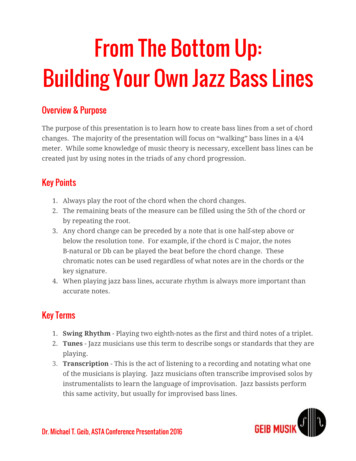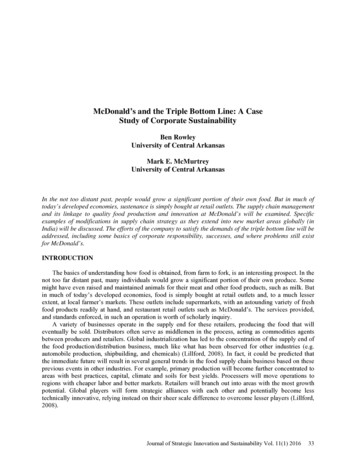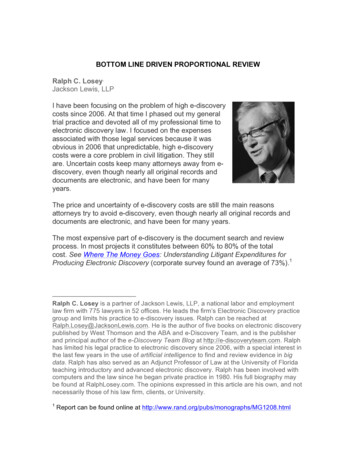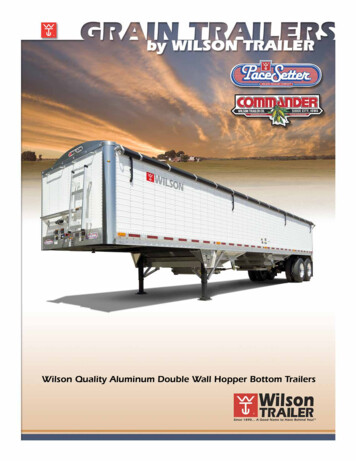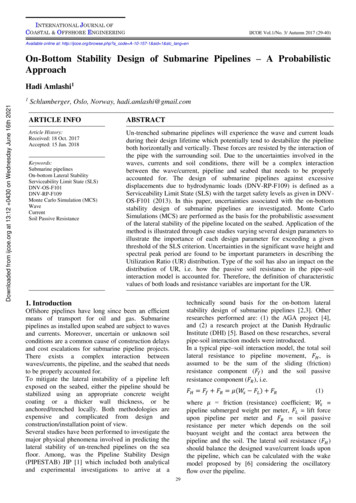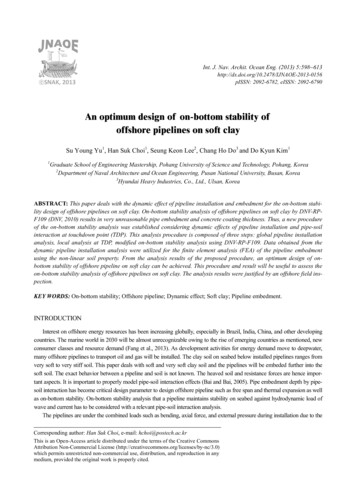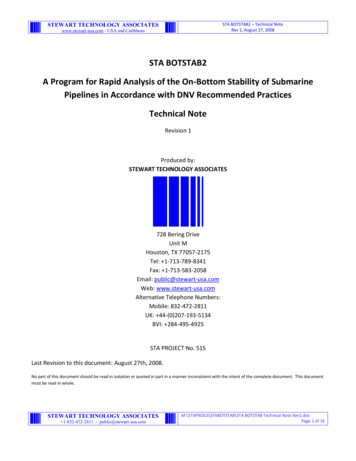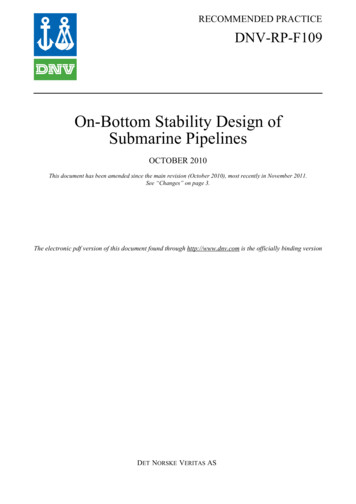
Transcription
RECOMMENDED PRACTICEDNV-RP-F109On-Bottom Stability Design ofSubmarine PipelinesOCTOBER 2010This document has been amended since the main revision (October 2010), most recently in November 2011.See “Changes” on page 3.The electronic pdf version of this document found through http://www.dnv.com is the officially binding versionDET NORSKE VERITAS AS
FOREWORDDET NORSKE VERITAS (DNV) is an autonomous and independent foundation with the objectives of safeguarding life,property and the environment, at sea and onshore. DNV undertakes classification, certification, and other verification andconsultancy services relating to quality of ships, offshore units and installations, and onshore industries worldwide, andcarries out research in relation to these functions.DNV service documents consist of amongst other the following types of documents:— Service Specifications. Procedual requirements.— Standards. Technical requirements.— Recommended Practices. Guidance.The Standards and Recommended Practices are offered within the following areas:A) Qualification, Quality and Safety MethodologyB) Materials TechnologyC) StructuresD) SystemsE) Special FacilitiesF) Pipelines and RisersG) Asset OperationH) Marine OperationsJ) Cleaner EnergyO) Subsea Systems Det Norske Veritas AS October 2010Any comments may be sent by e-mail to rules@dnv.comFor subscription orders or information about subscription terms, please use distribution@dnv.comComputer Typesetting (Adobe Frame Maker) by Det Norske VeritasThis service document has been prepared based on available knowledge, technology and/or information at the time of issuance of this document, and is believed to reflect the best ofcontemporary technology. The use of this document by others than DNV is at the user's sole risk. DNV does not accept any liability or responsibility for loss or damages resulting fromany use of this document.
Amended November 2011see note on front coverRecommended Practice DNV-RP-F109, October 2010Changes – Page 3CHANGESGeneralAs of October 2010 all DNV service documents are primarily published electronically.In order to ensure a practical transition from the “print” scheme to the “electronic” scheme, all documentshaving incorporated amendments and corrections more recent than the date of the latest printed issue, have beengiven the date October 2010.An overview of DNV service documents, their update status and historical “amendments and corrections” maybe found through http://www.dnv.com/resources/rules standards/.Main changes October 2010Since the previous edition (October 2007), this document has been amended, most recently in April 2009. Allchanges have been incorporated and a new date (October 2010) has been given as explained under "General".Amendments November 2011The description of Main changes were corrected and the document layout was updated to reflect the currentstandard.ACKNOWLEDGEMENTSThe following companies are gratefully acknowledged for their contributions to this Recommended Practice:DHIHydroMarintekPRCIStatoilWoodsideDNV is grateful for the valuable cooperation and discussions with the individual personnel representing thesecompanies.DET NORSKE VERITAS AS
Recommended Practice DNV-RP-F109, October 2010Page 4 – ContentsAmended November 2011see note on front coverCONTENTS1.General. 51.1 Introduction.51.2 Objective .51.3 Relationships to other codes .51.4 Safety philosophy.51.5 Symbols.52.Design . 72.1 Target failure probability .72.2 Load combinations.72.3 Weight calculations.82.4 Resistance calculations .82.5 Design criterion.83.Design Methods . 83.1 Introduction.83.2 Vertical stability in water.93.3 Vertical stability on and in soil .93.4 Dynamic lateral stability analysis .93.5 Generalized lateral stability method .203.6 Absolute lateral static stability method.234.Miscellaneous. 284.1 Free spans.284.2 Mitigating measures.284.3 Curved laying.284.4 Seabed stability .284.5 Soil liquefaction .295.References. 29Appendix A.Stability curves for clay. 31Appendix B.Carbonate Soils . 40DET NORSKE VERITAS AS
Recommended Practice DNV-RP-F109, October 20101. General – Page 51. General1.1 IntroductionThe present document considers on-bottom stability design for submarine pipelines subjected to wave andcurrent loading. The premises of the document are based on technical development and experience.The basic principles applied in this document are in agreement with most recognised rules and reflect state-ofthe-art industry practice and latest research.Other data and/or methods than those described herein may be used if a sufficient level of safety can bedocumented.1.2 ObjectiveThe main objective of this document is to provide rational design criteria and guidance for assessment ofpipeline on-bottom stability subjected to wave and current loading.1.3 Relationships to other codesThis document formally supports and complies with the DNV Offshore Standard “Submarine PipelineSystems”, DNV-OS-F101, 2000 and is considered to be a supplement to relevant National Rules andRegulations.In case of conflict between requirements of this RP and a referenced DNV Offshore Code, the requirements ofthe code with the latest revision date shall prevail.In case of conflict between requirements of this code and a non DNV referenced document, the requirementsof this code shall prevail.Guidance note:Any conflict is intended to be removed in next revision of that ---1.4 Safety philosophyThe safety philosophy adopted herein complies with section 2 in DNV-OS-F101.The design of submarine pipelines against excessive displacement due to hydrodynamic loads is ensured byuse of a Load and Resistance Factors Design Format (LRFD).For the absolute stability criterion, the set of safety factors is calibrated to acceptable failure probabilities usingreliability-based methods.For other design criteria, the recommended safety level is based on engineering judgement in order to obtain asafety level equivalent to modern industry practice.1.5 Symbols1.5.1 LatinApAwbdd50DgGPipe outer area including coating π D 2 / 4 .Orbital semi-diameter of water particles K D / 2π .Pipe buoyancy per unit length ρ w g π D 2 / 4 .Water depth.Mean grain size.Pipe outer diameter including all coating.Acceleration of gravity. Should be taken as 9.81m/s2.Transfer function.GcSoil (clay) strength parameter su.D γ sGsSoil (sand) density parameter γ s'.g ρwFYFZFRFCHsH*Horizontal hydrodynamic (drag and inertia) load.Vertical hydrodynamic (lift) load.Passive soil resistance, Ref. Eq. 3.23.Vertical contact force between pipe and soil, Ref. Eq. 3.24.Significant wave height during a sea state.Maximum wave height during a sea state.DET NORSKE VERITAS AS
Recommended Practice DNV-RP-F109, October 2010Page 6 – 1. GeneralKbkEquivalent sand roughness parameter 2.5·d50.ω2 k tanh k d .Wave number given bykTkURatio between period of single design oscillation and design spectrum T * / Tu .Ratio between oscillatory velocity amplitude of single design oscillation and design spectrum U * / U s .kVKK*Ratio between steady velocity component applied with single design oscillation and with design spectrum.Significant Keulegan-Carpenter number U s Tu / D .Keulegan-Carpenter number for single design oscillation U * T * / D .LSignificant weight parameter L*Weight parameter related to single design oscillation MM*MnSteady to oscillatory velocity ratio for designspectrum V / U s .Steady to oscillatory velocity ratio for single design oscillation V* /U*.Spectral moment of order n.NSpectral acceleration factor rtotrpenrtrrpermRDssgLoad reduction factor.Load reduction factor due to penetration.Load reduction factor due to trench.Load reduction factor due to a permeable seabed.Reduction factor due to spectral directionality and spreading.Spectral spreading exponent.Pipe specific density (ws b ) / b .sussSηηUn-drained clay shear strength.Relative grain density.Wave spectral densityTuSpectrally derived mean zero up-crossing period 2 π M 0 / M 2 .TpTnT*UwUsUs θU*VV*wsyYzzrz0zpztPeak period for design spectrum.Reference period d / g .Period associated with single design oscillation.Wave induced water particle velocity.Spectrally derived oscillatory velocity (significant amplitude) for design spectrum, perpendicular to pipeline.Spectrally derived oscillatory velocity (significant amplitude) for design spectrum, at an angle θ to the pipeline.Oscillatory velocity amplitude for single design oscillation, perpendicular to pipeline.Steady current velocity associated with design spectrum, perpendicular to pipeline.Steady current velocity associated with design oscillation, perpendicular to pipeline.Pipe submerged weight per unit length.Lateral pipe displacementNon-dimensional lateral pipe displacement y / D .Elevation above sea bed.Reference measurement height over sea bed.Bottom roughness parameter.Penetration depth.Trench depth.gws.0.5 ρ w D U s2ws(0.5 ρ w D U * V *)2.Us.g TuDET NORSKE VERITAS AS
Recommended Practice DNV-RP-F109, October 20102. Design – Page 71.5.2 GreekαμθθcθwρwGeneralised Phillips’ constant.Coefficient of friction.Shields parameter.Angle between current direction and pipe.Angle between wave heading and pipe.Mass density of water, for sea water normally equal to 1 025 kg/m3.γ SCγWγsγ s'Safety factor.ϕcττsωωpSafety factor.Dry unit soil weight. Can be taken as 18 000 N/m3 for clay.Submerged unit soil weight. For sand normally in the range 7 000 (very loose) to 13 500 N/m3 (very dense).Angle of friction, cohesionless soilNumber of oscillations in the design bottom velocity spectrum T / TuShear stress applied from water flow to seabed, Ref. Eq. 4.3.Wave frequency 2π / TPeak wave frequency 2π / Tp2. Design2.1 Target failure probabilityExcessive lateral displacement due to the action of hydrodynamic loads is considered to be a serviceability limitstate SLS with the target safety levels given in DNV-OS-F101., Ref. /1/.If this displacement leads to significant strains and stresses in the pipe itself, these load effects should be dealtwith in accordance with e.g. DNV-OS-F101.2.2 Load combinationsThe characteristic load condition shall reflect the most probable extreme response over a specified design timeperiod.For permanent operational conditions and temporary phases with duration i
Recommended Practice DNV-RP-F109, October 2010 2. Design – Page 7 1.5.2 Greek 2. Design 2.1 Target failure probability Excessive lateral displacement due to the action of hydrodynamic loads is considered to be a serviceability limit state SLS with the target safety levels given in DNV-OS-F101., Ref. /1/. If this displacement leads to significant strains and stresses in the pipe itself, these .
